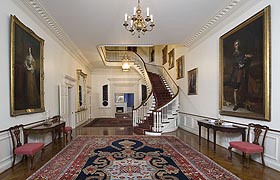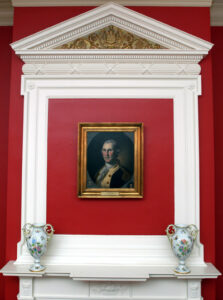
Entrance Hall, Government House, Annapolis in 2009
Located in Annapolis next to the State House, the Government House is the official residence of the Governor of Maryland. The Government House has been the home of Maryland Governors since 1870, when Governor Oden Bowie and his family became its first residents. Now home to Maryland’s 63rd Governor Wes Moore and his family, the Victorian-style residence was built at the end of the nineteenth century. However, in 1935, renovations on the house began and over the course of the twentieth century the home’s appearance was altered, leading it to its current Georgian-style appearance.

Drawing Room with painting of George Washington by Charles Willson Peale
Prior to the construction of Government House, there was no permanent home for Maryland governors. In 1733, the Maryland General Assembly authorized the purchase of land for an official house for the governor. In 1742, land was bought, and construction for a small house commenced. However, the building was never completed, and the unfinished dwelling was given to St. John’s College after the Revolutionary War. Without an official residence, Maryland Governors from 1753-1869 resided in Edmund Jennings’ house. Jennings was a Secretary of the Province of Maryland and Chief Judge, and his property was later sold to the U.S. Naval Academy. In 1868, the land on present-day’s State’s Circle was bought for the Governor’s residence. Baltimore architect R. Snowden Andrews designed the new mansion, making it eclectic to incorporate architectural ideas from Egypt, Italy, and France. The Government House was completed in 1870.
In 1980, the General Assembly authorized the creation of the Government House Trust. This group oversees the renovation, furnishing, and design of the house’s State-owned rooms. It also landscapes the grounds of the house and conserves the objects in the State rooms.
Government House has amassed many valuable pieces of art and furniture throughout its lifetime. There are portraits of Queen Henrietta Maria and Frederick Douglass, in addition to Charles Willson’s Peale’s painting of George Washington from the Revolutionary War (pictured). There is a Thomas Johnson Clock and Kirk Stieff antique silverware. Visitors to the house can explore its Public Rooms: The Entrance Hall, The State Dining Room, The Federal Parlor, or The Conservatory.

